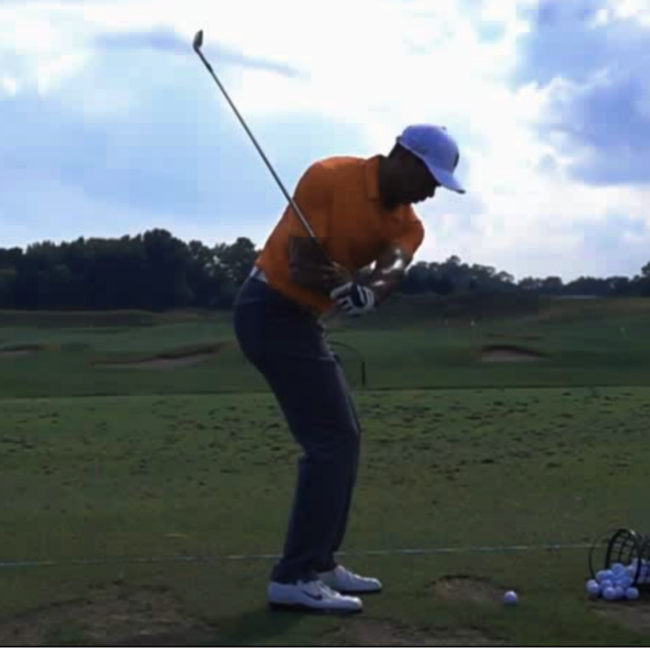Instruction
What We Learned: Jim Herman’s win at the Shell Houston Open

For me, Jim Herman’s win at the Shell Houston Open was one of the stories of the year so far… more so than Adam Scott’s two wins in a row, and Jason Day’s rise to No. 1 in the World Rankings. That’s because so called “journeymen” don’t usually win on the PGA Tour.
Here’s what you can learn from Jim Herman, a seven-time Q-School participant, former shirt folder and now a PGA Tour winner.
Practice Chipping from Uneven Lies
The shot Herman will be remembered most happened on No. 16 in the final round. It’s a par-3, and he missed the green to the left. He was a little lucky to avoid the bunker, but was left with an uphill chip out of the rough, which he duly holed under what must’ve felt like huge pressure on his shoulders considering he had just five top-10 finishes in his previous 105 events. Henrik Stenson, a man in form and potential favorite for the Masters, was also breathing down his neck.
Golfers tend to overcomplicate these shots when the lie is uneven, opting to change their swing to accommodate these lies. What many don’t know is that they should simply be adjusting their setup for better results.
For example, for uphill and downhill chips, lean your body WITH the slope, not against it. The instant reaction when approaching a shot like this is to lean INTO the slope to help maintain balance. The trouble is, for both uphill and downhill lies, you will not achieve the correct attack angle needed to help promote solid contact. The trick is to position your shoulders parallel to the slope at setup. If you don’t, you are decreasing your chances of contacting the ball as well as you could, and the risk of thins and duffs become more substantial.
Most of all, practice these shots. So many players tell me this is a weak area of their game, but they also rarely practice it. Make it fun and pressure-packed, like giving yourself the goal of making two in a row before you leave. You might be late for dinner, but you will have great fun in doing so and you will hone a rock solid short game, even when the lie isn’t perfect.
Shallow the Shaft
Two of the most impressive PGA Tour stats of Jim Herman’s game is his total driving, a combination of driving accuracy and distance in which he ranks T7, and approach shots from 200-225 yards, where he ranks 17th.
A big reason for this is due to his neat and tidy action from the top of the swing into the change of direction, where the shaft of the golf club shallows out as it starts the downswing. This leads to an ideal angle of attack and a slight inside path, a great combination for the long game.
Far too many amateurs do the opposite on the way down; the shaft gets steep in the transition and leads to any number of bad shots. For all of you lucky enough to have a mirror on your driving range, try this drill that has helped Jim Herman to his first PGA Tour win. Those who don’t can also practice at home in any reflective surface that’s large enough.
The Drill: Halfway in your downswing, set the club to a 45-degree angle so if there was an extension of the butt end of the club, it would be pointing at your ball on the ground. If your shaft was too upright at this point, the angle of the shaft will pointing (in clock face terms) to 12 p.m. and the imaginary extension from the butt end of the club will be pointing more towards your toes.
- LIKE11
- LEGIT1
- WOW0
- LOL0
- IDHT1
- FLOP0
- OB0
- SHANK1
Instruction
Clement: Laid-off or perfect fade? Across-the-line or perfect draw?

Some call the image on the left laid off, but if you are hitting a fade, this could be a perfect backswing for it! Same for across the line for a draw! Stop racking your brain with perceived mistakes and simply match backswing to shot shape!
- LIKE0
- LEGIT0
- WOW0
- LOL0
- IDHT0
- FLOP0
- OB0
- SHANK0
Instruction
The Wedge Guy: The easiest-to-learn golf basic

My golf learning began with this simple fact – if you don’t have a fundamentally sound hold on the golf club, it is practically impossible for your body to execute a fundamentally sound golf swing. I’m still a big believer that the golf swing is much easier to execute if you begin with the proper hold on the club.
As you might imagine, I come into contact with hundreds of golfers of all skill levels. And it is very rare to see a good player with a bad hold on the golf club. There are some exceptions, for sure, but they are very few and very far between, and they typically have beat so many balls with their poor grip that they’ve found a way to work around it.
The reality of biophysics is that the body moves only in certain ways – and the particulars of the way you hold the golf club can totally prevent a sound swing motion that allows the club to release properly through the impact zone. The wonderful thing is that anyone can learn how to put a fundamentally sound hold on the golf club, and you can practice it anywhere your hands are not otherwise engaged, like watching TV or just sitting and relaxing.
Whether you prefer an overlap, interlock or full-finger (not baseball!) grip on the club, the same fundamentals apply. Here are the major grip faults I see most often, in the order of the frequency:
Mis-aligned hands
By this I mean that the palms of the two hands are not parallel to each other. Too many golfers have a weak left hand and strong right, or vice versa. The easiest way to learn how to hold the club with your palms aligned properly is to grip a plain wooden ruler or yardstick. It forces the hands to align properly and shows you how that feels. If you grip and re-grip a yardstick several times, then grip a club, you’ll see that the learning curve is almost immediate.
The position of the grip in the upper/left hand
I also observe many golfers who have the butt of the grip too far into the heel pad of the upper hand (the left hand for right-handed players). It’s amazing how much easier it is to release the club through the ball if even 1/4-1/2″ of the butt is beyond the left heel pad. Try this yourself to see what I mean. Swing the club freely with just your left hand and notice the difference in its release from when you hold it at the end of the grip, versus gripping down even a half inch.
To help you really understand how this works, go to the range and hit shots with your five-iron gripped down a full inch to make the club the same length as your seven-iron. You will probably see an amazing shot shape difference, and likely not see as much distance loss as you would expect.
Too much lower (right) hand on the club
It seems like almost all golfers of 8-10 handicap or higher have the club too far into the palm of the lower hand, because that feels “good” if you are trying to control the path of the clubhead to the ball. But the golf swing is not an effort to hit at the ball – it is a swing of the club. The proper hold on the club has the grip underneath the pad at the base of the fingers. This will likely feel “weak” to you — like you cannot control the club like that. EXACTLY. You should not be trying to control the club with your lower/master hand.
Gripping too tightly
Nearly all golfers hold the club too tightly, which tenses up the forearms and prevents a proper release of the club through impact. In order for the club to move back and through properly, you must feel that the club is controlled by the last three fingers of the upper hand, and the middle two fingers of the lower hand. If you engage your thumbs and forefingers in “holding” the club, the result will almost always be a grip that is too tight. Try this for yourself. Hold the club in your upper hand only, and squeeze firmly with just the last three fingers, with the forefinger and thumb off the club entirely. You have good control, but your forearms are not tense. Then begin to squeeze down with your thumb and forefinger and observe the tensing of the entire forearm. This is the way we are made, so the key to preventing tenseness in the arms is to hold the club very lightly with the “pinchers” — the thumbs and forefingers.
So, those are what I believe are the four fundamentals of a good grip. Anyone can learn them in their home or office very quickly. There is no easier way to improve your ball striking consistency and add distance than giving more attention to the way you hold the golf club.
More from the Wedge Guy
- The Wedge Guy: Golf mastery begins with your wedge game
- The Wedge Guy: Why golf is 20 times harder than brain surgery
- The Wedge Guy: Musings on the golf ball rollback
- LIKE86
- LEGIT13
- WOW6
- LOL1
- IDHT0
- FLOP4
- OB1
- SHANK8
Instruction
Clement: Stop ripping off your swing with this drill!

Not the dreaded headcover under the armpit drill! As if your body is defective and can’t function by itself! Have you seen how incredible the human machine is with all the incredible feats of agility all kinds of athletes are accomplishing? You think your body is so defective (the good Lord is laughing his head off at you) that it needs a headcover tucked under the armpit so you can swing like T-Rex?
- LIKE0
- LEGIT2
- WOW2
- LOL0
- IDHT0
- FLOP0
- OB0
- SHANK2
-

 19th Hole2 weeks ago
19th Hole2 weeks agoDave Portnoy places monstrous outright bet for the 2024 Masters
-

 19th Hole3 days ago
19th Hole3 days agoJustin Thomas on the equipment choice of Scottie Scheffler that he thinks is ‘weird’
-

 19th Hole2 weeks ago
19th Hole2 weeks agoTiger Woods arrives at 2024 Masters equipped with a putter that may surprise you
-

 19th Hole3 days ago
19th Hole3 days ago‘Absolutely crazy’ – Major champ lays into Patrick Cantlay over his decision on final hole of RBC Heritage
-

 19th Hole3 weeks ago
19th Hole3 weeks agoReport: Tiger Woods has ‘eliminated sex’ in preparation for the 2024 Masters
-

 19th Hole1 week ago
19th Hole1 week agoTwo star names reportedly blanked Jon Rahm all week at the Masters
-

 19th Hole1 week ago
19th Hole1 week agoReport: LIV Golf identifies latest star name they hope to sign to breakaway tour
-

 19th Hole1 week ago
19th Hole1 week agoNeal Shipley presser ends in awkward fashion after reporter claims Tiger handed him note on 8th fairway















